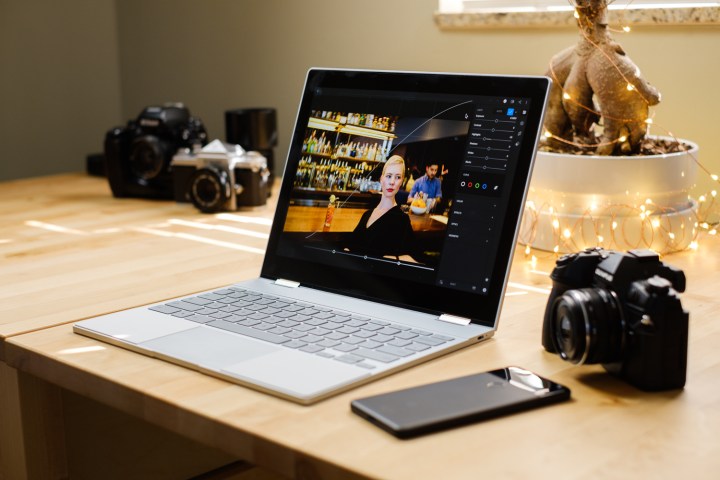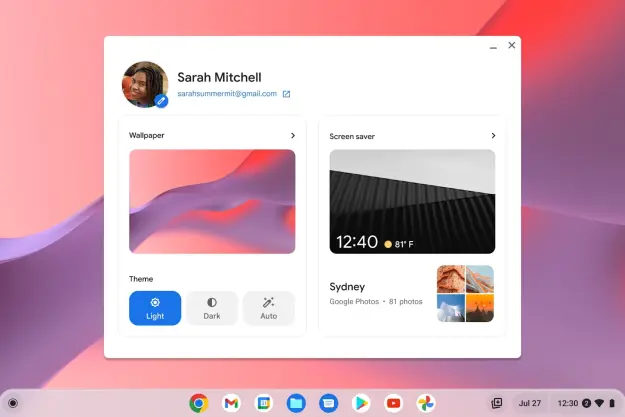If Google is the father of Chromebooks, then its Pixelbooks are its Chrome OS offspring. While that may sound a little dramatic, it signifies that you’ll get a quality product straight from the source like Mac is to Apple and Surface is to Microsoft.
What that means to you is that the Pixelbook serves as the champion of all Chromebooks, the primary example of the experience you should expect from a Chrome OS device. But like any other creator, Google didn’t churn out just one work of art. Now the Pixelbook Go is the cheaper alternative, providing the same first-class experience in a slightly different way.
In this Pixelbook Go vs. Pixelbook comparison, we’ll explain what makes these two Chromebooks both similar and different so you can decide which model is right for you.
Design

The big difference between the original Pixelbook and Pixelbook Go is the overall design.
The Pixelbook is a convertible 2-in-1, meaning you can flip the screen beyond the traditional clamshell design in most laptops. Google followed up with the Pixel Slate which is a detachable 2-in-1, another word for a tablet with an optional keyboard that combines to make a laptop. The Pixelbook Go, then, is just a traditional clamshell laptop. In this sense, Google covers all three laptop styles under the Pixel umbrella.
That said, the original Pixelbook and its Go sibling target two different markets. The Pixelbook Go is the larger device at 12.3 inches wide, 0.5 inches thick, and a 13.3-inch screen. The Pixelbook, meanwhile, is 11.43 inches wide, 0.41 inches thick, and sports a 12.3-inch screen.
Staying with the screen, both devices have some chunky bezels, though the Pixelbook Go has at least trimmed some off the side. The Pixelbook is locked to a 2400 x 1600 resolution whereas the Go serves up two options, depending on the configuration: 1920 x 1080 (Full HD) or 3840 x 2160 (4K) via its Molecular Display.
What you’ll likely notice the most is the screen’s aspect ratio: 16:9 on the Go and 3:2 on the Pixelbook. We tend to prefer the boxier shape of the Pixelbook, allowing for a taller view of your content.

Another obvious difference between the two laptops is in the materials. The original Pixelbook is made of an elegant mix of glass and aluminum. It’s extremely rigid in the hand and features a unique two-tone Silver/White design on the lid and keyboard deck.
The Pixelbook Go has a much simpler design but features some interesting flourishes as well. The bottom of the laptop is a bumpy texture that Google says makes it easier to grip and carry. It’s made out of magnesium, a light but less luxurious material. It’s only offered in two colors which we found either to be too formal (Black) or too loud (Not Pink).
One of the best new features of the Pixelbook Go is the new speaker placement. They are located on the keyboard deck, which is better situated for providing clearer audio directly to your ears. The speakers on the Pixelbook are inside the hinges on the keyboard side, creating a “tinny” sound that seemingly resonates through the keyboard.
Finally, both devices feature the same options for ports: Two USB-C — one on either side — and a 3.5mm audio jack.
Performance

A generation separates the processors used in Google’s two Pixel-branded laptops.
The Pixelbook has the older chips: Intel’s seventh-generation i5-7Y57 or i7-7Y75, depending on the configuration. The Pixelbook Go is the newer device, therefore it has newer Intel processors with an added third option: The eighth-generation m3-8100Ym, the i5-8200Y, and the i7-8500Y.
That “Y” denotes the use of extremely low power on mobile devices. This translates to fanless designs because the chips aren’t generating lots of heat, but that doesn’t mean they’re slow or underpowered. For Chromebooks, the Pixelbooks represent the high-end in terms of performance because of the light and efficient design of Chrome OS.
When comparing the two generations, you shouldn’t expect a huge difference in performance, but the Pixelbook Go may be a bit quicker when matched in configurations. Still, we like numbers, as they can show baseline performance, so here are their Geekbench single- and multi-core test results:
| Single | Multi | ||
| i5-7Y57 | 672 | 1097 | Pixelbook |
| m3-8100Y | 687 | 1108 | Pixelbook Go |
| i5-8200Y | 746 | 1279 | Pixelbook Go |
| i7-7Y75 | 780 | 1185 | Pixelbook |
| i7-8500Y | 788 | 1293 | Pixelbook Go |
Keep in mind that these benchmarks were run through an Android app, which isn’t native, meaning the numbers could be slightly higher if Geekbench offered a Chrome OS version. Still, you can see the slight performance boost in the 8th-gen chips over the previous generation. Even the m3 chip outperforms the 7th-gen Core i5 CPU.
Still, Google didn’t originally design Chrome OS as your typical PC platform. It targeted web apps that didn’t require actual downloads. That means the OS itself is lightweight, leading to storage capacities that are extremely small. That has since changed over the years as Google added support for Android apps and Linux-based software, both of which run through built-in emulators.
In both cases, however, we tend to find that Intel Core processors feel zippier, maybe even overkill, for basic Chrome OS functions. It’s when you dive into the Android and Linux aspects that you may feel the pinch of these “Y” chips. Chromebooks aren’t meant to run AutoCAD or Destiny 2, but you should see good performance using web applications and non-graphics-heavy
Portability
The Pixelbook and Pixelbook Go are nearly matched in terms of size and portability. As we previously stated, the Pixelbook is 0.412 inches thick whereas the

The battery is where you’ll see a huge difference here. The Pixelbook has a 41WHr battery that promises up to 10 hours. The Pixelbook Go has either a 47WHr (FHD) or 56WHr (4K) battery, both promising up to 12 hours. Just in Google’s claims alone, the Go has a two-hour lead.
In real-world numbers, the Go has one of the best battery life endurances we’ve ever tested on a Chromebook. It lasted over 13 hours in both our web browsing and video loops tests. We saw good performance in the Pixelbook battery too, but the Go was our clear winner in this scenario.
The Pixelbook Go is no Pixelbook 2
The most important feature of the Pixelbook Go is its price. One of the biggest hang-ups with the original Pixelbook has always been its $999 starting price. It was always a bit outside what the average person expected to pay for a Chromebook.

Google knows that, which is why the Pixelbook Go starts at just $649. That makes it a fantastic purchase for students and those who just need a cheap laptop for basic needs. That base configuration lands you the m3 chip, 8GB of RAM, 64GB of storage, and a Full HD display.
When you get into the higher configurations of the Go, the choice is trickier. For instance, the 4K model comes in only one configuration: Core i7, 16GB of RAM, and 256GB of storage for $1,399. The Core i5 configuration with 16GB of
What you need to keep in mind now is that Google no longer directly sells the Pixelbook. It’s an older laptop, so you’ll now only find it preconfigured through third-party merchants like Amazon. In fact, Google no longer even sells the Pixel Slate, leaving the Pixelbook Go as your only current choice through Google. It doesn’t have the cool 2-in-1 aspect seen in the Pixelbook and Pixel Slate, but it makes up that shortcoming in overall performance and price.
If you want to match dollar for dollar, the Go’s $999 configuration has the newer Core i5 CPU, a bigger screen, twice the RAM, but is limited to the clamshell design and Full HD resolution. Meanwhile, the Pixelbook has the older Core i5, half the
Overall, with its different design and cheap build quality, the Pixelbook will remain the go-to for high-end Chromebooks, at least for now until the Pixelbook 2 arrives, while the Pixelbook Go seems better value in its cheaper configurations.
Editors' Recommendations
- The most common Chromebook problems and how to fix them
- Chrome has a security problem — here’s how Google is fixing it
- The best Chromebook for students for 2023
- The best Chromebooks for kids
- The Pixelbook dream may finally be gone for good


